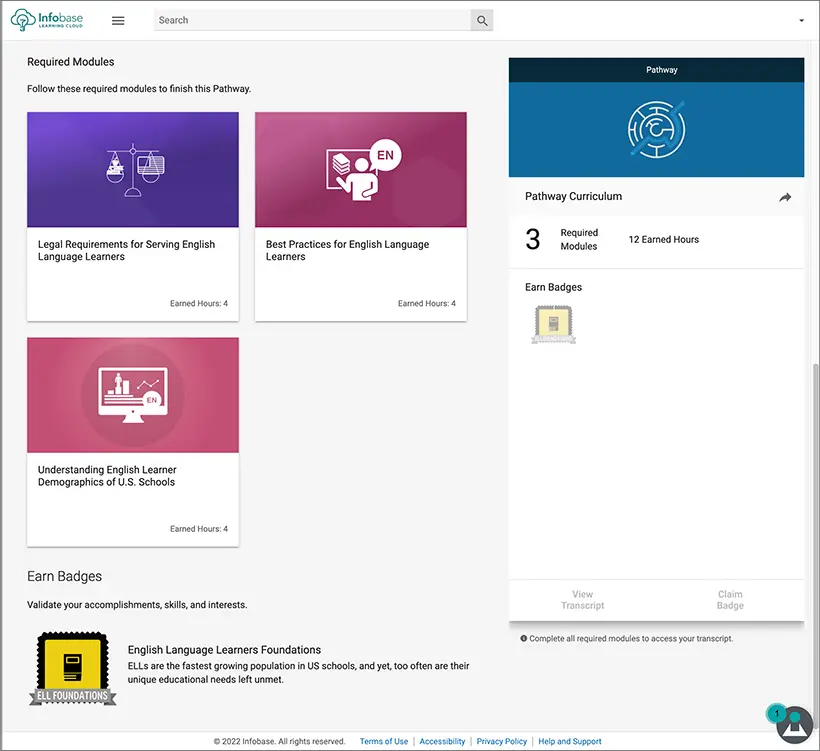The changing nature of work as well as technological and medical advances are intensifying the need for individuals to be able to learn continuously throughout their careers. For individuals to be successful, it is important they’re aware of these factors and are motivated to seek continuous learning.
As part of a research initiative by SHRM and Willis Towers Watson, 94% of Chief People Officers indicated that it was necessary to move from episodic training to perpetual reskilling as a way to handle the changing nature of work.1 The need to learn on an ongoing basis is partially based on the fact that the skills employers demand can change rapidly and frequently. For example, a Gartner report identified that 33% of the skills listed in a typical job posting in 2017 were no longer necessary in 2021.2
Among the technologies most responsible for facilitating this trend is automation; a McKinsey Global Institute study reported that half of today’s work activities could be automated by 2055. Digging deeper, most occupations cannot be fully automated whereas about 60% of all occupations consist of at least 30% automatable activities.3 To further illustrate the impact of automation, researchers from the University of Oxford found that 47% of workers may be at risk of losing their jobs.4
Medical advances are also increasing the need for lifelong learning. As stated in a Forbes article written by VelvetJobs CEO Pavel Krapivin, “medical advances mean that the majority of children born today will live to 100 years of age. This longevity … predicate[s] a transition towards a more multistage life that will see working, learning and resting blend into one.”5 With the rapid change in what skills are valued and a longer working life that further distances individuals from their formal education, it will be necessary to be able to learn skills during an individual’s working years.
The changing nature of work, rapid change in demanded skills, the advancement of technologies that may replace workers and make certain skills obsolete, and longer life expectancies all challenge the traditional three-stage model of study, work, and retirement. A major consideration in addressing this need for continuous learning is ensuring that individuals are motivated and engaged, and this includes the use of digital badges.
What Are Digital Badges?
Digital badges are indicators of an acquired skill or other accomplishment that can be displayed, shared, accessed, and authenticated online. Digital badges allow recipients to use an image to display their achievements or acquisition of a new skill, and this allows badges to be shared easily across online platforms. Digital badges have embedded metadata that contains information about who received the badge and when the badge was issued, as well the criteria for issuing such badges. This metadata is useful in ensuring that badges are authentic and the skills the badges represent have been validated. Furthermore, digital badges gain value from the reputation and prestige of the association that has awarded the badge.
Companies have many use cases for digital badges, such as increasing efficiency and scalability of hiring practices. Companies can also use digital badges to encourage employees to acquire necessary skills.
Digital badges can be very effective at motivating learners, as was experienced when IBM developed a digital badge program. In the weeks following launch, enrollments increased by 129%, the proportion of students who completed courses increased by 226%, and the number of students passing the end of course exam increased by 694%.6 It’s worth noting that this occurred without any other contributing factors, such as announcements from IBM executives or promotion.
Additionally, 87% of learners said they were more engaged due to IBM’s digital badge program. A reason for this engagement is the ability to use digital badges to strengthen resumes, and because of this 92% of surveyed learners said IBM digital badges improved their employability.6
Harvard Business Publishing conducted a survey of corporate learners and discovered that badging was widely wanted, because “for many, earning a badge makes learning more fun and gives them a reason for a bit of celebration … people do seem to enjoy a gesture as simple as an onscreen toss of a handful of virtual confetti when they achieve a milestone – as an incentive to keep learning.”7 Beyond corporate learners digital badges have been popular with students, a survey at Alamo College revealed the student experience with badges was positive.8
Gamification and Digital Badges
An aspect of digital badges that contributes to their effectiveness as motivators is gamification, which occurs when game elements are incorporated into a learning environment. Digital badges are gamified in that they symbolize achievements that have been earned after actions have been completed.
Gamification of learning and badging are part of a larger effort to make learning more engaging and learner friendly, and this goal is at the core of Infobase Learning Cloud’s learning experience. Infobase Learning Cloud is an e-learning platform that incorporates bite-size learning segments, learner flexibility, and self-paced learning—as well as badging—to effectively deliver training, professional development, and career and technology skills.

All of Learning Cloud’s courses are built around an outcome-based learning framework, which consists of microlearning videos and other items that can be completed at any individual’s pace. When multiple related courses are joined together, a pathway is formed, and select pathways in Learning Cloud offer badges for completing all course items for all required courses. One such pathway is Leadership Strategies, where a digital badge can be earned after the four required courses—Effective Meetings, Leadership Styles, How Do I Build an Effective Leadership Team? and The Art of Influence—are completed. Badging at the pathway level can motivate learners to complete a larger and more comprehensive task, all at their own pace and with a way to share and verify their achievements.
The changing nature of work as well as technological and medical advances are intensifying the need for individuals to be able to learn continuously throughout their careers. Learning Cloud can be a resource in this era of continuous learning due to its extensive content library and achievable, self-paced digital badges that can help keep learners motivated.
See also:
- How to Upskill Yourself Toward Professional Advancement
- How to Foster a Culture of Learning in the Digital Workplace
- 6 Best Practices When Training Remote Employees
- FREE webinar: When the Ground Shakes: Not Losing Yourself & Your Work in the Midst of Organizational Change
References
- Simon King and Suzanne McAndrew, “5 Steps to Powering Continuous Learning in an Evolving Workplace,” Insights (blog), WTW, November 19, 2019, https://www.wtwco.com/en-US/Insights/2019/11/5-steps-to-powering-continuous-learning-in-an-evolving-workplace.
- Eric Friedman, “The Importance Of Reskilling Your Workforce In 2021,” Forbes, October 20, 2021, https://www.forbes.com/sites/forbeshumanresourcescouncil/2021/10/20/the-importance-of-reskilling-your-workforce-in-2021/?sh=1dccf1be685b
- James Manyika et al., “A Future That Works: Automation, Employment, and Productivity,” McKinsey & Company, January 12, 2017, https://www.mckinsey.com/featured-insights/digital-disruption/harnessing-automation-for-a-future-that-works/de-DE.
- The Data Team, “A Study Finds Nearly Half of Jobs Are Vulnerable to Automation,” Graphic Detail (daily chart), The Economist, April 24, 2018, https://www.economist.com/graphic-detail/2018/04/24/a-study-finds-nearly-half-of-jobs-are-vulnerable-to-automation.
- Pavel Krapivin, “The Study, Work, Retire Model Is Broken As We Live Until 100,” Forbes, August 13, 2018, https://www.forbes.com/sites/pavelkrapivin/2018/08/13/the-study-work-retire-model-is-broken-as-we-live-until-one-hundred/?sh=62d9a6027bd4
- David Leaser, “Do Digital Badges Really Provide Value to Businesses?,” IBM Training and Skills Blog, IBM, June 18, 2019, https://www.ibm.com/blogs/ibm-training/do-digital-badges-really-provide-value-to-businesses/.
- Hallie Boger, “Want Learner Engagement? Don’t Overlook the Power of Badging,” Leading the Way (blog), Harvard Business Publishing, September 30, 2021, https://www.harvardbusiness.org/want-learner-engagement-dont-overlook-the-power-of-badging/.
- “The Importance of Digital Badges,” Online Student Blog, Alamo Colleges District, May 19, 2021, https://www.alamo.edu/online/blog/2021/may/the-importance-of-digital-badges/.


